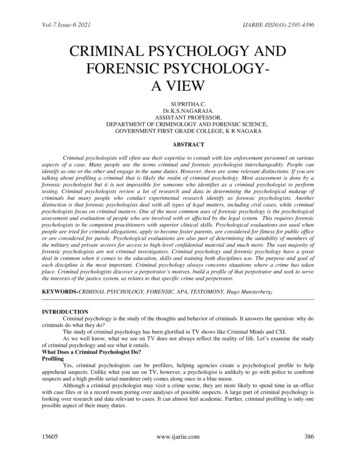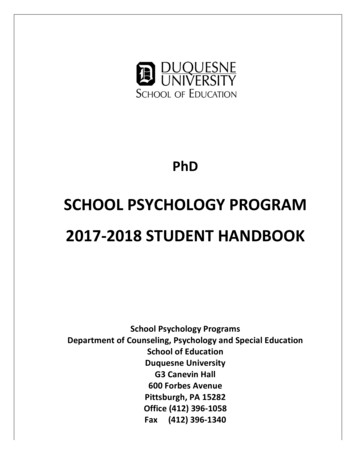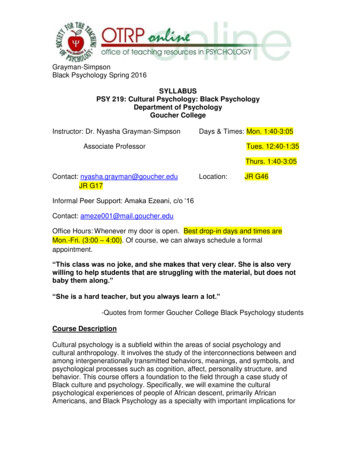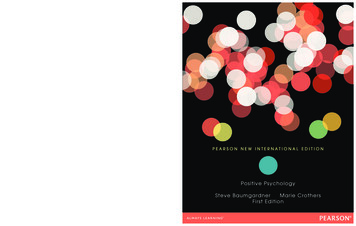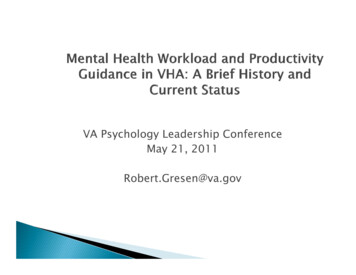
Transcription
VA Psychology Leadership ConferenceMay 21, 2011Robert.Gresen@va.gov
History and current status of Mental HealthProviderinPid ProductivityP di i GuidanceG idi VHA Identify the primary measures of productivity for VHAmental health providers and methods for obtaining thatinformation. Understand the strengthsstrengths, vulnerabilities and challenges ofdetermining mental health provider productivity usingavailable national data systems. Draft Directive establishing MH Providery beingg reviewed byy VACOProductivity
Commissioned by VA to establish staffingguidelines Completed in 1977, but failed to recommend anyguidelines as projected workload (need) could notbe calculatedd d VA establishbli h productivitydi i standardsd d RRecommended
GAO (1981) criticized VA for lack ofproductivity standards VA mandated a Staffing Guidelines initiative VA Psychology developed a Staffing Guidelinesmethodology that classified all psychology activitiesinto 11 patient care and 6professional/administrativefil/ d i i t ti categoriesti 28 pilot sites chosen() Data collected (1984) Episodes of care and time spent for clinical work; Time estimates for various clinical activities Prof/administrative efforteffort- time spent only
47% in direct patient care; another 26% inpatient care support activities (consultation,tteammeetings )ti)MethodologyMth d lcouldld hhave bbeen usedd ttocalculate productivity standards and staffingguidelines, but never mandated; left to localdiscretion
In January 2003,2003 the Deputy Under Secretaryfor Health charged a VHA Advisory Group onPhysician Productivity to develop productivitymodels for VHA physicians EEvaluateltheh relativel i productivitydi i off ffull-timell ianddpart-time VHA physicians in comparison withexternal benchmarks Develop a prototype infrastructure for conductingphysician productivity and staffing studies acrosshealth care specialties in VHA
VHA Advisory Group on Physician Productivitydevelopeddld a RelativeR l i ValueV l UnitU i (RVU)** basedbdmodel to measure productivity and provide staffingguidance for medical specialtygpypproviders.Primary Care (PC) also developed a productivitymodeld ldduringithithis same titime periodi dbbasedd on panellsize.**RVUs Weights assigned to CPT codes reflecting time,complexity, etc. Initially developed by Medicare fory used to assess pprovider pproductivity.yreimbursement but widely
Product of a work group charged to develop MHprovider productivity guidance. Coordinated by the Office of Mental HealthServices and composed of mental health stafffrom VISNs 3, 6, 12, 16, 20 and 21andrepresentatives for Psychology, Psychiatry, SocialWork and Nursing. Reviewed methodologies being developed oralready in place in the field and the publishedliterature.
Primary approach of the workgroup conceptual Identify hours available for clinical work Tried to account for all clinician time Develop guidance for a “typical” MH provider National data not availableData available to various degrees withinspecific VISNs.
Intended to provide guidance to evaluateappropriate workload levels for individual mentalhealth providers for two levels of inpatient mentalhealth care, a mental health clinic setting and onetype of residential rehabilitation program.NOT intended to address staffing standards orpatterns in mental health treatment programs.NOT intended to establish mandatory workloadstandards at the national level for mental healthproviders.
MentalM t l HealthH lth ClinicCli i Not intended for use in subspecialty programs Inpatient Mental Health Acute,Acute high intensity Non-acute, lower intensity Residential (SARRTP)
Business Rules (Primary Care) Guidelines provided in several metrics Panel size (uniques) Encounters Work Relative Value Units (wRVUs)*
Guidelines did take into account: Full time clinical assignment without major leadership or administrativeresponsibilityibilit Vacation and sick leave Clinical supervision of students, trainees, interns, residents, etc. Training, staff meetings, committee work, etc. typical of a front lineclinician Patient care support activities (e.g., team meetings, documentation,telephone calls, etc.) Guidelines did not take into account commitments for non-clinical activitiesincluding Research education/training activities other than clinical trainee supervisionth professionalfildti suchh as EAP service,iC&P exams, etc.t otherduties Adequacy of support personnel and other resources that support clinicalpractice Local variations (e.g., no-show rates; wait times; urban versus ruralg ) and practicepppatternssettings) Case mix factors
PsychiatristPsychologistSocial WorkerGeneric Group vs Individual PsychotherapyProvider
ProviderPanel 45-3979Psychologist24017402349-3236Social 7517403236Group therapist96777364564
OPES: decentralized VA Central Office program located in VISN 1.Goal: To promote VHA leadership among healthcare organizationsin the utilization of clinical resources,resources and to optimize clinicalproductivity, efficiency and effectiveness in staffing.Purpose: To provide effective management tools for thesystematic, longitudinal measurement and reporting of clinicalproductivity, efficiency and staffing in VHA. The Office willproduce recommendations for standards and guidance toenhance the provision of Safe, Efficient, Effective andCompassionatepCare.
Established within OPES in June,June 2007Develop logistsygSocial WorkersAdvanced Practice Providers (NP, CNS, PA)Primary Deliverable- Draft Directive
Mental Health Productivity & Staffing WorkgroupMental Health Productivity & Staffing Workgroup:Robert Gresen, PhD, ChairpersonIra Katz,, MDAntonette Zeiss, PhD, Deputy Chief Mental Health ServicesLisa Dixon, MDHoward Goldman, MDSuzanne Thorne‐OdemBradley Karlin, PhDTinai Lee, MDJohn Petek, MSWJeffrey Peters, MDJeffrey Quarles, MRC, LICDCEthan Rofman, MDJoni RubinMary Schohn, PhDAdam Wolkin, MDDenni WoodmanseeVHA Office of Productivity, Efficiency & StaffingVHA Support Service Center (VSSC)Decision Support System (DSS)Allocation Resource Center (ARC)18
VHA Mental HealthWorkforceFY 2009FY 2009PsychiatristsPsychologistsSocial WorkersAdvancedPracticeProvidersMH FTEE / TotalFTEE (%)1896.8 / 1896.8(100%)2074 / 2459.8(84%)3204.9 /5847.4(55%)1051.5 / 5731.2(18%)Direct MH CareFTEE (% of MHFTEE)1627.9 (86%)1909 (92%)2962 (92%)988.8 (94%)Outpatient MHFTEE (% of DirectMH FTEE)13791379.66 (85%)15851585.55 (83%)21912191.55 (74%)779779.88 (79%)
VHA Total Mental Health FTE per 1,000 Unique Enrolled Veteransby VISN (FY10)
Percent Change in VHA Total Mental Health FTE per 1,000 UniqueEnrolled Veterans by VISN from FY09-FY10 (Growth Rate)FY 2008 - 2009
81108210841085Physical TherapistOccupational TherapistOther TherapistsSocial WorkerSocial Worker Aides and TPharmacistsPsychology Aides and TechRegistered NursesNurse PractitionersLPNs and LVNsNursing Aides and NursingClinical Nurse SpecialistPhysicians ‐ Full TimePhysiciansh‐ Part TimePhysicians AssistantsClinical Psychologists anFY 200518.2496.721,042.071,891.72224 295.281,546.91217.50180.541,229.96FY 200618.3596.191,212.602,010.66211 280.871,587.10215.63180.561,279.44FY 200718.66101.501,334.102,346.53221 271.821,639.95221.35193.511,441.03FY 200820.42104.211,448.602,844.80239 276.521,819.68253.39210.801,788.52FY 200922.60113.571,515.003,510.87245 256.392,013.17274.88216.012,122.74FY 201020.86115.131,547.214,155.21258 263.532,163.49289.35217.582,464.88FY 2009 FY 2010% Change % Change(From 05) (From 100%Core mental Health Total13,950.11 14,207.66 15,064.95 17,127.20 19,252.46 20,853.92Source: Allocation Resource Center (ARC): Monthly Program Cost Report3 (MPCR3) Run Date: 4/4/201138%49%
Outpatient Mental HealthEncounters and Uniques (FY05(FY05-FY10)Outpatient Mental Health Encounters, UniquesFY 2005 - FY 2010Source: VSSC NPCD Outpatient Cube (4/4/11)18,000,00016,000,0001,600,00047% Change in # Encounters (From 05)43% Change in # Uniques (From 05)1,400,00014,000,0001,200,000Clinic otal Outpatient Encounters 10,608,689Unique MH 1,031,8001,129,3571,224,5431,333,928*Note: FY09 figures revised to exclude residual encounter/unique patient volume in 531 MH Medical Primary Care ClinicsUnique MH Outpatients12,000,000
Comprehensive Literature Review:The literature supports measurement of Mental Health productivity usingvarious metrics: wRVUs, Panel Size, Encounters and ADC. Overwhelmingly,wRVUs are most often used to measure productivity for Licensed IndependentPractitioners (LIPs).Benchmarks:Medical Group Management Association (MGMA) and scientific studiespublished in the literatureWorkload:Wkl dPsychiatrists, Psychologists, Advanced Practice Nurses (NP, CNS), PhysicianAssistants and Social Workers were identified by person class designation. ForPsychiatrists, outpatient CPT codes were associated with CMS wRVUs containedwithin the PhysicianProductivityCPT codes wereyy Cube. For others,, Outpatientpassociated with CMS wRVUs contained within the National Patient CareDatabase (NPCD). Encounters and Unique Patients were obtained from theNPCD for all provider groups. Inpatient workload (ADC) data were obtainedfrom the DSS Discharge Cube.24
Workforce: Psychologist, Advanced Practice Provider and Social Work FTE werejfor time spentpin direct clinicalobtained from the MPCR3,, adjustedcare. Unlike physician labor mapping, DSS labor mapping for thesedisciplines is only available in aggregate, not by individual provider. Psychiatry FTE, adjusted for time spent in direct clinical care (MDFTEC) was obtainedFTEC),b i d ffrom DSS llaborb mappingiwhichhi h isi availableil blwithin the physician productivity cube.
Productivity Modifiers:Data regarding mental health support staff, mental healthproviderid staffingffilevels,ll teachinghimission,i ifacilityf ili andd patienticharacteristics were considered as potential practicemodifiers. Modifier variables hypothesized to be associatedwith productivity were tested for significance using standardstatisticali i l techniques.h iStudy Period:The time period of the initial study was from October 1,2006 through September 30, 2007 (FY 2007) and FY 2008.
Mental Health Clinics* are defined as:if clinic (CL) or credit clinic (CLC)stop between 500-599 or in(706 707 713 725 726 727 728 729)(706,707,713,725,726,727,728,729)except for psychology** allencounters regardless of CL or CLC.WorkloadAll Encounters ina Mental HealthClinic*ClinicEncountersUnique Patients(No Minimum CriteriaUtilized)Providers **ofPsychologist, SocialWork, NP, CNS, PA** Providersif provider1-10 420','010421') then psychologyif provider 110 in (('010600'010600 ,'010500'010500 ,'010100')010100 ) then social work1-10if provider 1-10in ('100000','100100','100200') then PAif provider 1-10 in 616') then NPif provider 1-10 in '100329','100330','100333') then CNSwRVUsEach CPT hooked to CMSwRVU, Supplemented withIngenix Gap Code RVU andVHA (ARC) Imputed RVUNote: If Multiple Providers** onencounter then workload given toeach discipline
Mental Health Clinics* are defined as:if clinic (CL)or credit clinic (CLC) stopb tbetween500500-599599 or iin(706,707,713,725,726,727,728,729)except for psychology** allencounters regardless of CL or CLC.WorkforceAll Direct Clinical FTE(Removes Admin,Research & Education) ina Mental Health Clinic*** Providers Budget Object Code (BOC) 1067 Clinical Nurse Specialists 1064 Nurse Practitioner 1085 & 1087 Clin & Counseling Psychologist 1020 Social Worker 1068 Physician Assistant
Workforce(From DSS Labor Maps)All Work Direct Clinical FTE(Removes Admin, Research &Education) removes BDOC* FTEUnique PatientsWorkload(No Minimum CriteriaUtili ed)Utilized)EncounterswRVUs(Each CPT hooked to CMS wRVU,Supplementedwith IngenixGapppgp CodeRVU and VHA Imputed C&P Exam RVU)
Aggregate d PsychiatryPhysician Person Class30
ProductivityP di i isi definedd fi d as :Workload/Adjusted FTE (C )*) Trainee (and non-LIP) workload identified on an encounterwith an LIP is credited to the LIP.** PPrimaryiworkloadkl d metrict i iin DDraftft DiDirectivetiwRVUsRVU
Outpatient data are robust CPT codes,codes encounters,encounters stop codes,codes wRVUs,wRVUs panel sizes Inpatient data Event capture; billable services Recommendation: Outpatient standard only
Psychology Productivity wRVUs per FTE (C), VISN Averages FY 200830002500VA Mean Productivity 2,043wRVVUs per FTE 201817
Psychology Practice Productivity wRVUs per FTE(C) FY 200870006000wRVUs pper FTE(C)50004000VHA Mean Productivityy 2,043,3000200010000VA Practices in Order of Ascending Productivity
Psychiatry Productivity wRVUs per MD FTE (C), VISN Averages FY 20084000.003500 003500.003000.00Work RVVUs per MD FTE ((C)VA Mean Productivity 3111197621VISN*Average of 133 practices, includes only outpatient productivity81018412165221517
Psychiatry Practice Productivity wRVUs per MD FTE (C) FY 20086,000wRRVUs per MD FTE(C)5,0004 0004,0003,000VA Mean Productivity 2,578*2,0001,0000VA Practices in Order of Ascending Productivity*Average of 133 practices; includes only outpatient workload
Residential (SARRTP) . Monthly Program Cost Report3 (MPCR3) Run Date: 4/4/2011. Outpatient Mental Health Encounters and Encounters and UniquesUniques (FY05(FY05--FY10)FY10) 18,000,000 1,600,000 Outpatient Mental Health Encounters, Uniques FY 2005 - FY 2010



